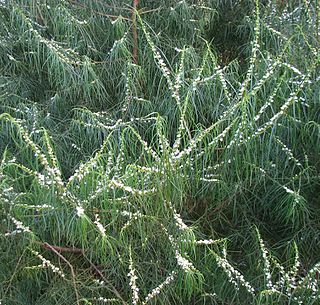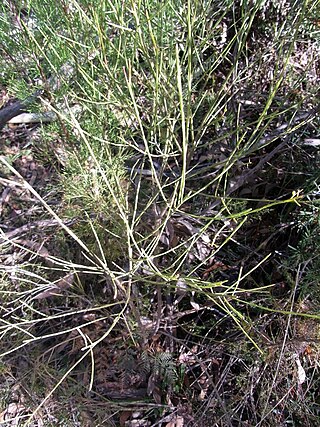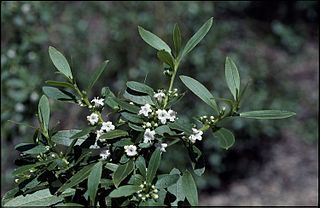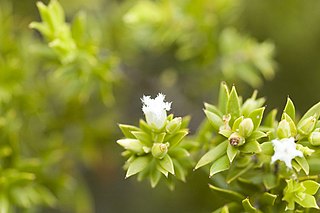
Myoporum is a genus of flowering plants in the figwort family, Scrophulariaceae. There are 30 species in the genus, eighteen of which are endemic to Australia although others are endemic to Pacific Islands, including New Zealand, and one is endemic to two Indian Ocean islands. They are shrubs or small trees with leaves that are arranged alternately and have white, occasionally pink flowers and a fruit that is a drupe.

Eremophila is a genus of more than 260 species of plants in the figwort family, Scrophulariaceae all of which are endemic to mainland Australia.. Eremophilas are widespread in the arid areas of Australia, especially Western Australia and range in size from low-growing shrubs to small trees. The petals are joined, at least at their bases, into a tube with the upper petals different in size and shape from the lower ones. Some species have common names including emu bush, poverty bush or fuchsia bush, reflecting the belief that emus eat the fruit, their arid environment or a superficial resemblance to the flowers of plants in the genus Fuchsia.

Eremophila debilis, the winter apple or amulla, is a flowering plant in the figwort family Scrophulariaceae, and is endemic to an area extending from north Queensland to near the border between New South Wales and Victoria in Australia. It is a prostrate shrub with elliptic to lance-shaped or egg-shaped leaves and white, rarely deep mauve flowers.

Myoporum insulare, commonly known as common boobialla, native juniper, is a species of flowering plant in the figwort family Scrophulariaceae and is endemic to coastal areas of Australia. It is a shrub or small tree which grows on dunes and coastal cliffs, is very salt tolerant and widely used in horticulture.

Myoporum parvifolium, commonly known as creeping boobialla, creeping myoporum, dwarf native myrtle or small leaved myoporum is a plant in the figwort family, Scrophulariaceae. It is a low, spreading shrub with long, trailing stems and white, star-shaped flowers and is endemic to southern Australia including Flinders Island.

Myoporum viscosum, commonly known as sticky boobialla, is a plant in the figwort family, Scrophulariaceae and is endemic to South Australia. It is unusual in that sometimes, especially when the leaves are crushed, it has an extremely unpleasant smell.

Myoporum acuminatum, commonly known as waterbush, pointed boobialla or mangrove boobialla, is a flowering plant in the figwort family Scrophulariaceae and is endemic to eastern Australia. It grows in rainforest or wet eucalyptus forest near the coast and in the Coastal Ranges, and is occasionally associated with mangroves. Occasionally it is found in the drier rainforests. It grows naturally as far south as Mimosa Rocks National Park in far south eastern New South Wales, and north to Fraser Island in Southern Queensland.

Myoporum floribundum, commonly known as weeping myoporum or slender myoporum, is a sour-smelling glabrous shrub in the family Scrophulariaceae endemic to a small area of New South Wales and Victoria in Australia. It has long, thin, drooping leaves and profuse white flowers in clusters along the stems in spring. Although it is uncommon in nature, it has long been available as a popular garden plant.

Leptomeria acida, known as acid drops or sour currant-bush, is an apparently leafless parasitic shrub, found on the coast and ranges in eastern Australia. The habitat is dry eucalyptus woodland, often in sheltered sites. This plant is a root parasite. Branchlets are stiff, angular and spreading. Red flowers form in summer on racemes, 15 to 20 mm long. The fruit is a green or reddish drupe, sometimes tinged with purple. Leaves are tiny, 1 to 2 mm long, though barely noticeable.

Myoporum caprarioides, commonly known as slender myoporum, is a plant in the figwort family, Scrophulariaceae. It is a shrub with wart-like tubercles covering its branches and leaves, especially on the upper surface and white flowers spotted with mauve, or all blue-mauve, present for most of the warmer months.
Myoporum crassifolium is a plant in the figwort family, Scrophulariaceae. It is a shrub or small tree with thick, fleshy leaves and small groups of white flowers spotted with pink or purple. It is endemic to New Caledonia, Vanuatu and the Loyalty Islands and is a rich source of the essential oil, bisabolol.
Myoporum mauritianum is a flowering plant in the figwort family Scrophulariaceae and is endemic to a few volcanic islands in the Indian Ocean. It is a small, low-branched shrub with serrated leaves and small white flowers and usually grows on calcarenite within 20 metres (70 ft) of the sea.

Myoporum obscurum, commonly known as popwood, sandalwood or bastard ironwood is a plant in the figwort family, Scrophulariaceae. It is a very rare shrub, endemic to Norfolk Island where it occurs in a few scattered locations.

Myoporum oppositifolium, commonly known as twin-leaf myoporum, is a plant in the figwort family, Scrophulariaceae. It is easily distinguished from others in the genus by the combination of glabrous leaves and branches, its opposite leaf arrangement and its serrated leaves. Its distribution is restricted to the extreme south-west of Western Australia.

Myoporum platycarpum, known by several common names including sugarwood, false sandalwood and ngural is a plant in the figwort family, Scrophulariaceae. It is rounded with bright green foliage as a young shrub and roughly fissured, dark grey bark when mature. Sugarwood is endemic to the southern half of continental Australia.

Leucopogon pendulus is a species of flowering plant in the heath family Ericaceae and is endemic to the south-west of Western Australia. It is an erect, straggling shrub with oblong leaves and white, tube-shaped flowers that are bearded inside.

Leucopogon muticus, commonly knwon as blunt beard-heath, is a species of flowering plant in the heath family Ericaceae and is endemic to eastern Australia. It is an erect, straggling shrub with egg-shaped leaves with the narrower end towards the base, and small numbers of white, tube-shaped flowers that are densely bearded inside.

Leucopogon acuminatus is a species of flowering plant in the heath family Ericaceae and is endemic to the Northern Territory. It is a compact, erect shrub with narrowly elliptic or lance-shaped leaves and small groups of white or cream-coloured flowers.

Leucopogon alternifolius is a species of flowering plant in the heath family Ericaceae and is endemic to south of Western Australia. It is a low, sprawling shrub with thin branchlets, egg-shaped leaves with a heart-shaped, stem-clasping base, and white or pale pink flowers arranged in up to twenty groups along the flowering branchlets.

Leucopogon leptospermoides is a species of flowering plant in the heath family Ericaceae and is endemic to eastern Australia. It is an erect, bushy shrub with elliptic to lance-shaped or oblong leaves, and white, tube-shaped flowers usually arranged singly in upper leaf axils.




















